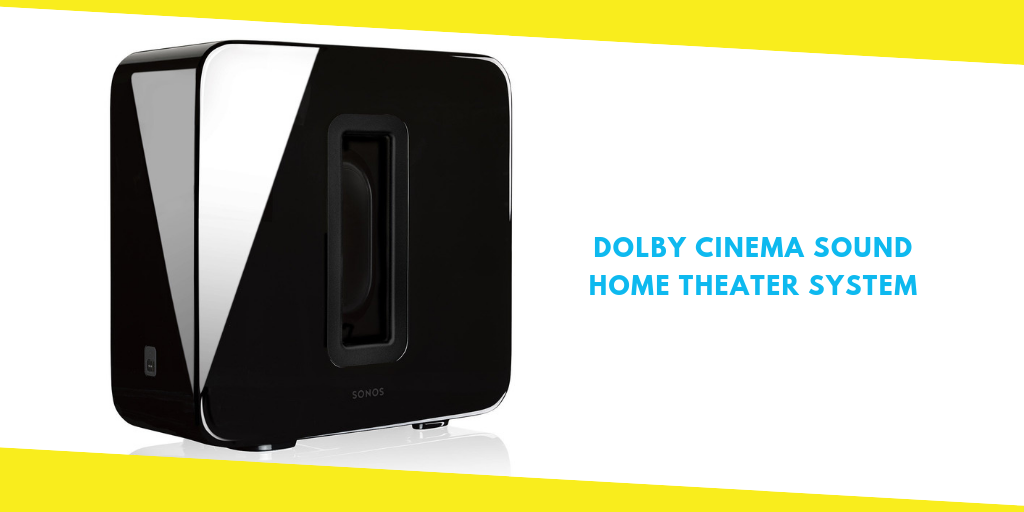Make Your Dream Dolby Cinema Sound Home Theater System With ‘Sonos’
This post was last updated on November 17th, 2018

Before making a ‘Dolby Cinema Sound Home Theater System’, we need to understand ‘Home Theater System’, ‘Dolby Cinema Sound’ and ‘Surround Sound’. Home cinema system also called home theater or home theatre states to home entertainment audio-visual systems that seek to reproduce a movie theater experience and temperament using consumer electronics-grade video and audio devices that are set up in a room or backyard of a private home. In the 1980s, home cinemas typically consisted of a movie pre-recorded on a LaserDisc or VHS tape; a Laser Disk or VHS player; and a heavy, bulky large-screen TV set.
Technological innovations in sound systems in the 2000s, video player equipment, and TV screens and video projectors like one of the best epson projectors have changed the equipment used in home theatre set-ups and enabled home users to understand a higher-resolution screen image, improved sound quality and mechanisms that offer users more options.
Today, a home cinema system typically uses a large projected image from a video projectors or a large flat-screen high-resolution HDTV system, a movie or other video content on a high-resolution Blu-ray disc or DVD, with the audio increased by a multi-channel power amplifier and anywhere from two speakers and a power amp with stereo sound to a 5.1 channel amplifier and five or more surround sound speaker filing cabinet (with a surround sound system). Whether home cinema fans have a stereo set-up or a 5.1 channel surround system, they usually use at least one low-frequency subwoofer speaker cabinet to amplify low-frequency effects from movie soundtracks and reproduce the deep playing field from the musical soundtrack.
Dolby Digital is the name for audio compression technologies which is developed by Dolby Laboratories. In 1994, it’s named ‘Dolby Stereo Digital’, its audio compression is lossy. The first use of Dolby Digital was to deliver digital sound in cinemas from 35mm film prints; today, it is now also used for other presentations such as TV broadcast, radio broadcast through satellite, DVDs, Blu-ray discs and game consoles.
Surround sound is a technique for enriching the fidelity of sound reproduction by using multiple audio channels from speakers that surround the listener (surround channels). Its first application was in movie theaters. Prior to surround sound, theater sound systems commonly had three “screen channels” of sound, from loudspeakers located in front of the audience at the left, center, and right. Surround sound adds one or more channels from loudspeakers behind the listener, able to create the sensation of sound coming from any horizontal direction 360° around the listener. Surround sound formats vary in reproduction and recording methods along with the number and positioning of additional channels. The most common surround sound specification, the ITU’s 5.1 standard, calls for 6 speakers: Center (C) in front of the listener, Left (L) and Right (R) at angles of 60° on one or the other side of the center, and Left Surround (LS) and Right Surround (RS) at angles of 100–120°, plus a subwoofer whose position is not critical.
According to the above description, you can make your dream Dolby Cinema Sound Home Theater System with ‘Sonos’. To make your dream Dolby Cinema Sound Home Theater System, you need a large flat-screen high-resolution HDTV, Sonos PLAYBAR TV Soundbar, Sonos SUB (woofer) and a couple of Sonos speaker such as ‘Sonos One’, ‘Sonos Play:3 or Play:5.
Contents
ToggleSonos PLAYBAR TV Soundbar
Sonos Playbar’s design with a super-slim shape measured by 85mm (H) x 900mm (W) x 140mm (D), the Playbar is specially designed to sit under a TV set, either laid flat on a table or mounted to the wall. Nicely placed nine amplified speaker drivers into it, seven are front faced and the rest two are placed both side panel with slightly upper angled which delivers ‘directionality’ crisp powerful sound. The Sonos Playbar isn’t covered by the smooth and soft fabric grille, it is made of aluminium – while many similar looks soundbars are made by plastic and covered by the smooth and soft fabric grille. The Playbar has provision for Dolby Digital, but it does not work with DTS audio signals. So, you will need to make sure your TV or Blu-ray player able to convert the signal which supported by the Playbar. The Playbar delivers the groundwork for a home cinema in your own living room. The width of the soundstage that’s created a mighty impressive, and mass tonal balance that any TV on its own simply can’t deliver.
Sonos SUB (Subwoofer)
Sonos always looking for ways to improve the experience with new products. The Sonos SUB is an addition to your present Sonos set up that claims to add extraordinary superior comfortable bass all-around and low-frequency response to improve the Sonos speakers you already own. It’ll be specific interest to Sonos customers those are love to add 3.1 or 5.1 cinema sound to their media rooms. The Sonos SUB is not the light bit of kit, nor is it small but it is very well-designed with measuring 15.83 x 14.96 x 6.22 (HLW) inch, and weighs 16kg. The ‘Sonos SUB’ subwoofer is in all likelihood a comparably smaller than most hi-fi subs. The cut out in the middle is where placed the two massive drivers. Part of the purpose of Sonos SUB stays so slim is that these drivers are not accurately round but stretched-out vertically. They fire straightforward at each other as part of some sort of sub-bass Mexican stand-off. The design and the exceptional combination that makes up the SUB’s body cuts much of the vibration make happen when pumping-out those low-frequency bass follow-ups. The SUB only vibrates lightly in use, even when cranked up. This design also makes it less finicky than most other hi-fi subs.
Sonos Speaker: Along with Sonos PLAYBAR and Sonos SUB, you have to use a couple of Sonos speaker such as Sonos One, Sonos PLAY:3 or Sonos PLAY:5 behind the sitting place in the room. Depending on the room’s size, you have to decide which Sonos’s speaker you will use.
- Sonos One: ‘Sonos One’ measuring Dimensions 4.72 x 4.72 x 6.34 inch with two drivers and Alexa built-in voice control. The ‘Sonos One’ is a mono speaker, but when you pair two of them together to get stereo sound as well as bigger volume and it will make an extraordinary difference in the listening experience. The disadvantages to the ‘Sonos One’ mostly come down to bass but when you use a couple of Sonos One along with Sonos Playbar and Sonos SUB for home theater system, you will never realize this bass lacking.
- Sonos PLAY:3: ‘Sonos PLAY:3’ is little bigger than Sonos One which Dimensions 12.3 x 9.5 x 8.6 inches with more robust sound than ‘Sonos One’ and deeper bass. PLAY: 3 delivers, in stereo. There are three Class-D amplifiers and three custom-built drivers create a full, wide soundstage so theinstruments and vocals really shine. There’s a bass radiator too which pump out the lows. It has no Alexa built-in but you can connect your PLAY:3 to any Amazon Echo or Alexa-enabled device.
- Sonos PLAY:5: ‘Sonos PLAY:5’ measuring Dimensions 14.3 x 8 x 6 inches with three ‘10 cm’ driver reason to move the mid-range. These three drivers are backup support by two ‘20 mm’ tweeters placed on the left and right of the device (in funnels) and one ‘22 mm’ tweeter in the middle. ‘Sonos PLAY:5’ is the record powerful speaker Sonos has produced. The ‘Sonos PLAY:5’ pairing speakers deliver sound truly good with better stereo separation and can be cranked to extremely loud volumes. But for small rooms, these can be almost too louder along with Sonos Playbar and Sonos SUB. It has also no Alexa built-in but you can connect your PLAY:3 to any Amazon Echo or Alexa-enabled device.
Our advice to make your dream ‘Dolby Cinema Sound Home Theater System’, if the room size is small, you should use the speaker ‘Sonos One’. For a mid-size room, you may use ‘Sonos PLAY:3’ and the room is bigger than mid-size, you can use ‘Sonos PLAY:5’. Sometimes it depends on listener’s test, some listener like to listen loud sound with heavy bass and some are not. But in both cases, you will find impressive surround Dolby Digital cinema sound and hear sub-sonic notes much clearer. There is an option for night mode, which crushes the dynamic range of the output – making loud sounds quieter and boosting soft sounds – depending on the volume, so as not to disturb sleeping children or neighbors.
Every speaker will sound different in each different room, as the resulting sound principally depends on your room’s acoustics, layout, decor and how the sound bounces off each surface to your ears. TruePlay is a feature that controls this process and acoustically familiarizes the speaker to each room. With above-mentioned speakers, Sonos will want to know from you to define where your viewing position is, so it knows how to adjust the sound according to the layout of your room. TruePlay feature is accessible with any Apple device and can be done as a part of the initial set up.
The above Sonos speaker setup through the Sonos app (supported by Android, iPhone, iPad or desktop), go into the app settings from the “More” button and section in the bottom right, tap on “Add a Player” then keep an eye on the instructions. These instructions will work while confirming the device is plugged in. In order to begin combined all four speakers, you’ll need Wi-Fi and a Sonos Bridge to connect your speakers to your Wi-Fi network. To get the TV’s sound working on the speakers, there is a little more effort required. Even though it’s all set-up actions are very straightforward and the procedure is easy enough with step-by-step guidance from the Sonos app. Eventually, in these steps, you’re setting up your TV to allow that you are going to use external speakers, which you’ll be able to do using the audio settings menu on your TV. The form of balancing the Speakers is the last stage of setup, followed by Trueplay, a technology Sonos introduced in 2015, which allows you to tune Sonos speakers to its atmospheres using an ‘iOS’ device (no Android yet miserably). Once again, you just need to monitor the instructions within the Sonos app to begin Trueplay adjusting.
Sonos recently redesigned Controller apps for Mac and Windows. In addition to an absolutely give a face-lift look, it will suggest an improved search box that committed to making it easier to find music across various services, expanded drag-and-drop functionality as well, accessible to sleep timer and alarm settings, “one-touch Party Mode”, which lets you adjust the volume in grouped speakers at the same time.
The above-combined speakers provide the groundwork for a ‘Dreaming Dolby Home Cinema Sound’ in your own living room. After setting up all the above speakers that dramatically improve overall bass output and you will get absolute ‘the Dolby Digital 5.1 surround sound’ which would be better than many brand compact Home Theater System. Not only that, but you can also stream your favorite music to it when the TV is off and enjoy music. You can easily add your music over 30 streaming services or stream free radio to these speakers.
Written by N K Khan
Recommended For You
How To Update Drivers In Windows PC
Most Inside
Most Inside offers high-quality recommendations and valuable updates to enhance all aspects of your life, providing premium guidance and enriching experiences.




